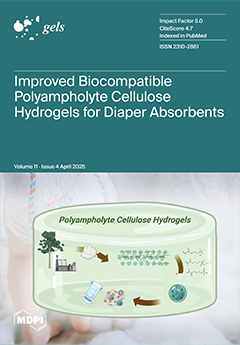Rapid industrialization has led to significant environmental challenges, particularly in wastewater treatment, where the removal of heavy metal ions and organic dyes is critical. This study presents the synthesis and characterization of a high-performance hydrogel adsorbent, (nanoclay)
x@poly-γ-glutamic acid (γ-PGA)/polyethyleneimine (PEI) hydrogel
[...] Read more.
Rapid industrialization has led to significant environmental challenges, particularly in wastewater treatment, where the removal of heavy metal ions and organic dyes is critical. This study presents the synthesis and characterization of a high-performance hydrogel adsorbent, (nanoclay)
x@poly-γ-glutamic acid (γ-PGA)/polyethyleneimine (PEI) hydrogel adsorbent (denoted as N
xPP, x = 0, 20, 40, 60, and 80), for the efficient removal of heavy metal ions (Cu
2+, Fe
3+, and Zn
2+) and organic dyes (Methylene blue, as a typical example) from wastewater. The hydrogel was prepared using a one-pot method, combining γ-PGA and PEI with varying amounts of nanoclay. The N
80PP hydrogel demonstrated exceptional adsorption capacities, achieving 224.37 mg/g for Cu
2+, 236.60 mg/g for Fe
3+, and 151.95 mg/g for Zn
2+ within 30 min, along with 88.18 mg/g for Methylene blue within 5 h. The incorporation of nanoclay significantly enhanced the mechanical properties, with compressive strength reaching 560.49 kPa. The hydrogel exhibited excellent reusability, maintaining high adsorption capacity after five cycles. The adsorption kinetics followed a pseudo-second-order model, and the isotherms fit the Freundlich model, indicating a multilayer adsorption mechanism. This study highlights the potential of N
xPP hydrogels as a versatile and sustainable solution for wastewater treatment.
Full article






